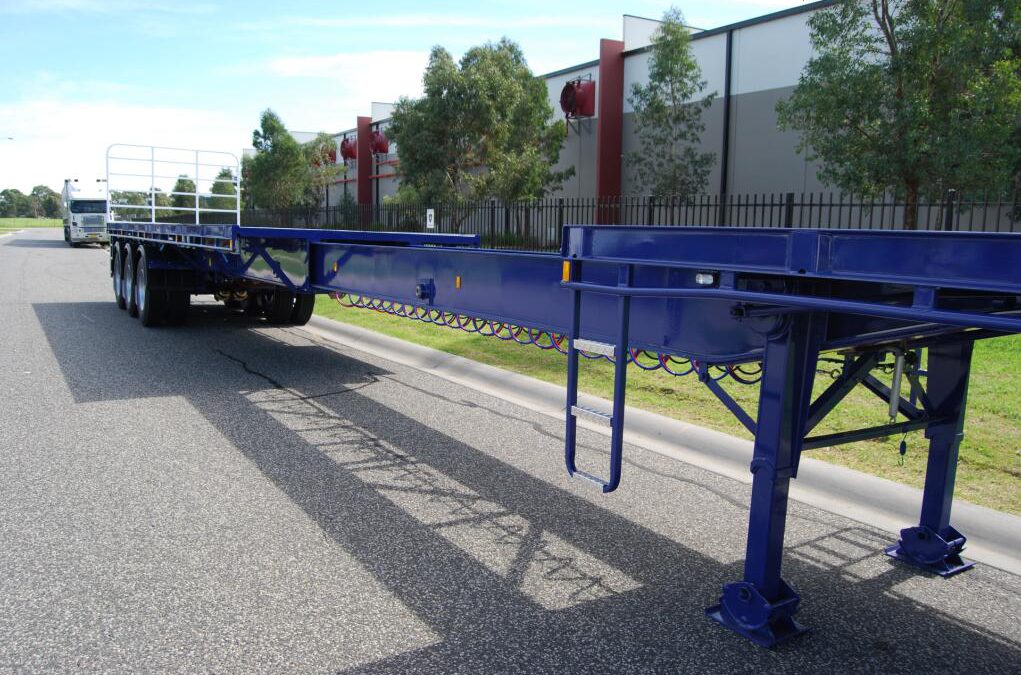The transportation industry has different types of vehicles and platforms that are used to meet different demands and needs. One such means of transportation used is the extendable trailer.
Just like is the case with other means of transportation, this type of trailer is suited for certain applications that would otherwise not be addressed through the use of other types of transportation platforms and/or vehicles.
Whether too long or too wide, any load can comfortably be loaded and transported using an extendable trailer towed by a tractor truck. Detailed in here is extensive information about what makes this type of trailer and where it is used.
Read More:
What is a Multi-Axles Trailer?
Wind turbine blade / windmill tower trailer buying guide
What is an extendable / telescopic trailer?
Table of Contents
One. What is an Extendable Trailer?
An extendable trailer configuration is a trailer mechanism that is designed and adapted to be towed through the use if a tractor truck travelling along a roadway.
The extension on the trailer is done efficiently take loads that may be of different lengths as the job will demand.
The mechanism of this type of trailer could include both a front and rear chassis disposed of in a telescoping connection where each of the chassis can be supported through the separate wheel and axle assemblies.
These could be inclined in a side by side connection in the contracted condition of the mechanism.
The disposition could be in spaced relation in the extended format of the mechanism.
Both the rear and front chassis cooperate in such a way that the chassis are inclined in a largely rigid connection
when the mechanism of the trailer is contracted and permissible articulation of the chassis frameworks about an overly horizontal axis following the extension of the trailer mechanism.
The devices forming up the locking mechanism are provided for purpose of securing the rear and front chassis frameworks in the assembly both in the extended and contracted status of the transporter mechanism.
The main components of the trailer are a power pack unit, gooseneck, wheel, supporting device, frame electrical system, hydraulic suspension, the braking system, ladder and the hydraulic system among others.
They are vital in defining the role and operations of extended trailers. These types of trailers can be configured in different ways: longitudinally or horizontally. Here are the TWO types of extendable trailer models:
- Longitudinally extendable trailers
- Wide Extendable trailers
Read More:
Modular Trailer Application – Learn the Advantage & Features
1.1 Longitudinally Extendable Trailers
Longitudinally extendable is commonly used to transport very long cargo, like tanks and windmill blades and bridge sections among other similar-like cargo.
To take these loads, the trailer is extended lengthwise. When it is not carrying any load, it needs to be adjusted back to a short length. Its application and use should, however, be based on the stipulated local laws and driving safety.
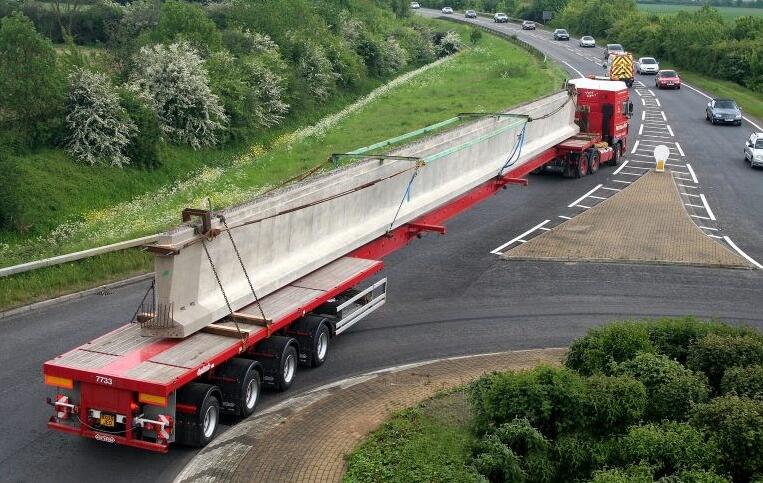
1.2 Wide Extendable Trailers
Wide extendable trailers are commonly used for taking loads that are big width-wise. The trailer is normally expanded horizontally to give room for such loads.
When it is not taking any load, it needs to be adjusted back to a short width based on the local laws and rules governing driving safety.
To meet the needs of the large-scale movement and transportation of wide cargo on roads, the frame width of the trailer gets adjusted to take up the job.
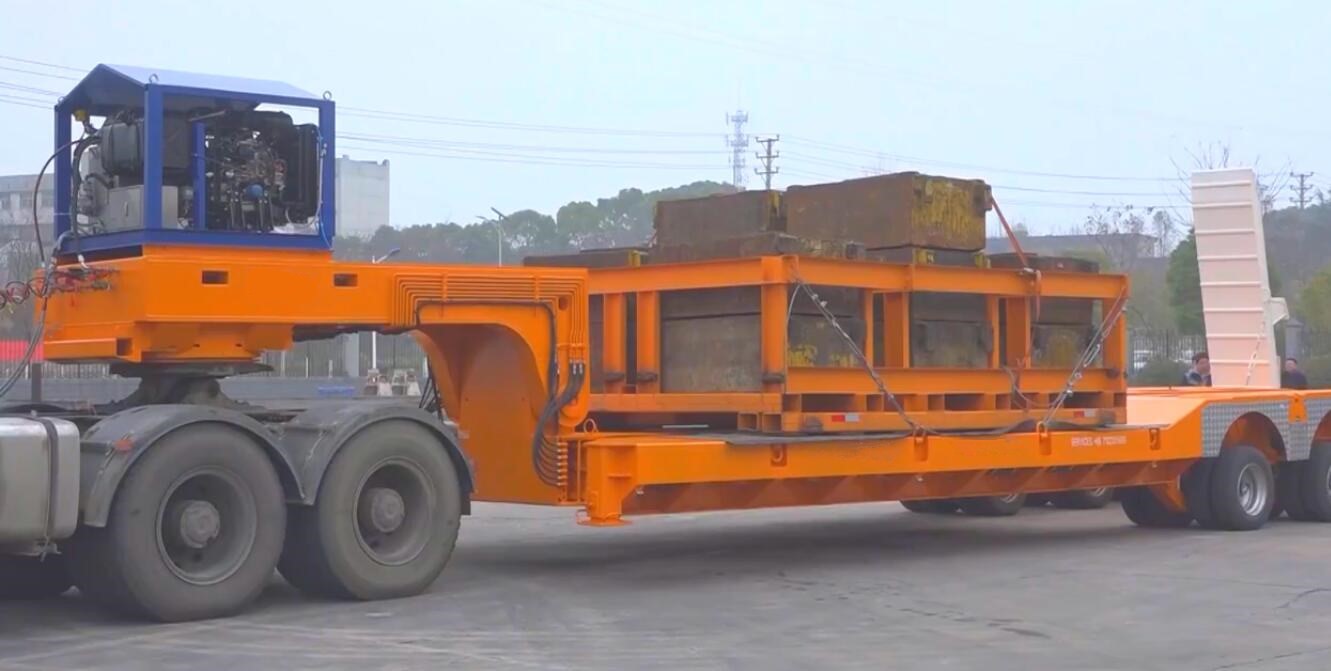
Two. Longitudinal Extendable Trailer Basic Configuration
A conventional extendable trailer configuration has a fixed frame and an additional frame that can be connected to the fixed one.
The second frame makes a slide-able contact with the fixed frame to provide the desired longitudinal extension.
This means that the free frame can move in a relative way to the fixed frame for purposes of either lengthening or shortening the apparatus of the trailer.
The movable frame is usually situated at the rear section of the tractor-towed trailer. This freely moving trailer is made up of a set of wheels and axle firmly secured to it.
Securing of the load is firmly made to the fixed frame.
Three. Wide Extendable Trailer Basic Configuration
This type of trailer is most applicable to such kind as are secured to tractors during the process of transporting loads.
This trailer mechanism is designed with possibilities of extending it to cater for loads of different lengths in preparation for towing by a tractor over a roadway.
Figure 2 Wide Extendable Trailers
The expansion type of trailer allows an increment to the trailer width to allow it to take a much wider load than most conventional loads.
Basically, this is a variable dimension structure designed for use as an expandable trailer mechanism to provide room width-wise for loads as would require such adjustments.
Ideally, this trailer structure comprises a floor with a minimum of two sections and sidewalls that have two sections each.
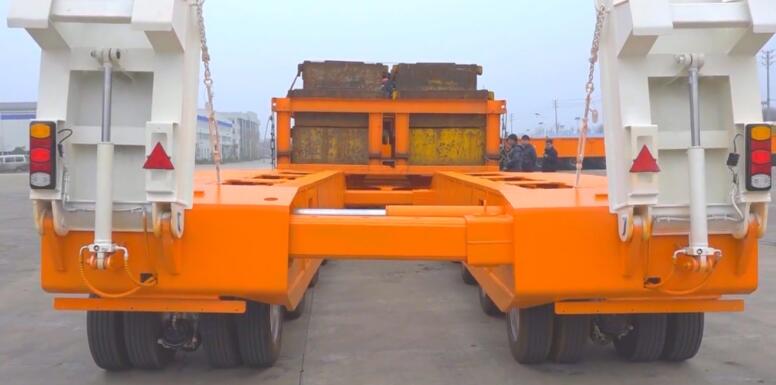
The said sections can be moved with the manual turning of a crank or through the use of an electrically powered motor via the provided power unit.
In this setup, there is a horizontal expansion that leads to an extension that occurs width-wise giving room for taking up maximum width loads.
When needed to take smaller loads width-wise, it can be contracted to provide a floor space that can contain the given load.
The manoeuvrability features are comparable to those of a ramp lift that can be adjusted to perfectly lift a given load off the ground.
Once the loading is done onto the expandable trailer, it can then be towed by a tractor to move it to the desired location.
These extendable trailers take different forms. A trailer mechanism is provided for coupling to a pivot-able trailer ramp to help during the manual lowering and lifting of a ramp.
The ramp’s lateral positioning is made possible in order to accommodate different load bases.
With such possibilities, you can make the most suitable adjustments to ensure that your load is safely seated on the trailer without fears of falling off during transportation.
Typically, extendable trailers make it possible for users to have many options that enhance the safety of their operations unlike when using fixed frames entirely.
Here is the specs of wide extendable trailer:
| Item | Parameter | |
| Size Parameters | Total length of trailer(mm) | Optional |
| Gooseneck total length/tail sweeping space radius | 3300/2200 mm | |
| Platform length(mm) | Optional | |
| Total height of the trailer (includes ladder) | 3690mm(-200 / +450 mm) | |
| Gooseneck height | 2040mm | |
| Gooseneck and tractor saddle height | 1390mm | |
| Frame height (can be raised and lowered) | 1080mm(-200 / +450 mm) | |
| Suspension lift total stroke | 650 mm | |
| Saddle center to first axis distance | Optional | |
| Wheelbase | 1500mm | |
| Vehicle width (can be extended) | 3000、3300、3600、3700 mm | |
| Track (can be extended) | Optional | |
| Single side ladder size (length × width) | Optional | |
| Structural parameters | Axis / Suspension / Number of wheels | Optional |
| Tire specifications | Optional | |
| Traction pin | 90mm (3.5”) | |
| Main structural material yield strength | ≥ 660 MPa | |
| Suspension maximum steering angle | 40° | |
| Trailer minimum turning radius | 11500 mm | |
| Weight parameters | Curb weight(kg) | Optional |
| Maximum load capacity | Optional | |
| Axle load | 26t @ 20km/h (16.4t @ 80km/h) | |
| 5th wheel load (saddle load) | 35t | |
| Dynamic performance | Full load maximum speed | 20 km/h |
| No-load maximum speed | 80 km/h | |
| Suspension System | Hydraulic lifting suspension | |
| Gooseneck type | Articulated gooseneck with hydraulic pitch and hydraulic steering | |
| Steering type | 3-axis full steering, synchronized with gooseneck hydraulic | |
| Brake type | Airbrake with ABS | |
| Width extension type | Articulated hydraulic extension | |
| Ramp type | Hydraulic ladder | |
Four. Key Components of the Extendable Trailer
The extendable trailer is a robust transportation platform with a gooseneck, a frame, axle assembly, various hydraulic systems,
the braking system, steering system, power pack unit, electrical equipment and so on. Here is a detailed look into how each of these parts are adapted to function:
Read More:
Ultimate Modular Trailers Buying Guide
4.1 The Gooseneck Feature
The trailer’s gooseneck feature is a hydraulic part that is usually adjusted through a telescopic expansion of the hydraulic cylinder.
The steering mechanism towing the extendable trailer is usually attached in the gooseneck.
The assembly and connection at the gooseneck point is usually made to the tractor saddle via the turntable, the wedge and the traction pin.
As the tractor rotates, the steering cylinder gets pushed and transmitted to the steering bridge of the trailer via the hydraulic circuit.
4.2 Trailer Frame
The extendable trailer frame construction features the main beam, half plates to the left side and the right side and a transverse device.
This is the main structure of the trailer that bears the load transported on it. The frame is of high-strength steel construction grade HG785/B700L/Q690 with at least 660MPa yield strength.
The half plates to the left and right side are linked to the main beam by means of the transverse device.
These half plates can be pushed through the oil cylinder to adjust the vehicle width and form the wheelbase expansion. The hydraulic gooseneck is attached to the frame head and a hydraulic ladder fitted at the rear section.
4.3 Axle Assembly and Hydraulic Suspension
The trailer has a vertical axis hydraulic lifting suspension that comprises a swing arm, a bogie, a single hole shaft, lifting cylinder and a wheel. The absolute suspension lift is 650mm.
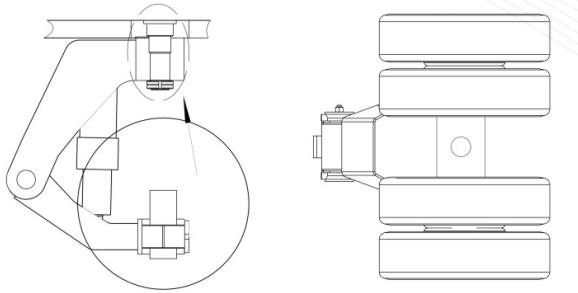
The wheels used are determined by the axle load in each of the different applications. In that case, wheels are 215/75 R17.5 tires with 6.75-17.5 steel rings. Every axis has eight (8) wheels, 2 hydraulic suspensions and axle assemblies.
4.4 The Steering System
The steering system of an extendable trailer comprises a wheel steering mechanism, gooseneck steering mechanism and a matching hydraulic synchronous control circuit.
The gooseneck steering mechanism makes use of the tractor’s rotation in relation to the trailer in order to contract and expand the steering cylinder in a synchronous manner in relation to the wheelset steering mechanism.
This then drives the axle via the steering rod and the turntable.
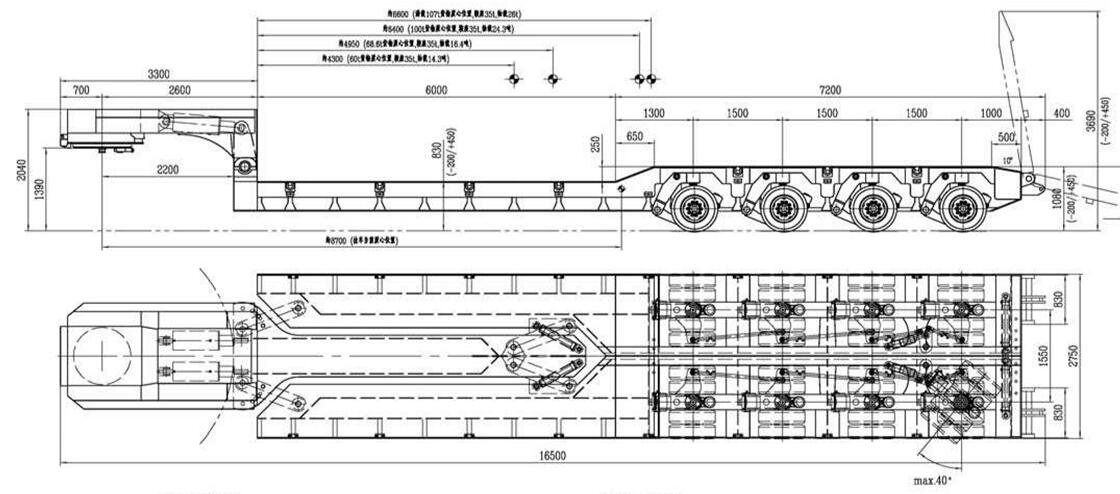
4.5 The Hydraulic System
The trailer has a hydraulic system that comprises control circuits like the suspension lifting, gooseneck lifting, synchronous steering, lateral adjustment and in lifting the ladder.
The basic components of the hydraulic system are hydraulic valve blocks, joints and pipes. The entire system comes with a hydraulic source by means of a power unit. There is also a safety valve installed in the circuit.
4.6 The Braking System
To further enhance swift operations with the extendable trailer, a braking system is provided. This includes a service brake, a dual-line automobile brake system and a parking brake.
The supply and control lines are set separately. The most significant components include a connector attached to the tractor,
an emergency relay valve, air reservoir, double-brake chamber and a number of specifications for the components connecting to the pipeline.
4.7 The Electrical System
A 24V single wire system forms the electrical system of the extendable trailer. In totality, the electrical system includes lights, connectors and wires among other components.
The electrical connection attached to the tractor chosen is the national standard 24N type electrical connector.
The external signalling and lighting components are usually provided with brake lights, rear position lights and position lights among other as deemed useful for use in this application.
4.8 The System’s Power Unit
The power unit is made up of a small diesel engine, which is the main prime mover. Other components include a hydraulic oil tank, control lines and pipelines, hydraulic pump. The unit offers a hydraulic source for the trailer’s hydraulic system.
Conclusion
Due to the varying demands of cargo in terms of size, particularly on its length and width, the need for establishing a lasting solution led to the making of extendable trailers.
Instead of buying fully-powered vehicles for carrying different loads of different lengths, an extendable trailer towed by a tractor can help cut down on the cost of buying many vehicles to suit different scenarios.
With an extendable trailer, you can now adjust the platform to accommodate different lengths of cargo and transport them comfortably using a tractor.
Trailers can be enlarged longitudinally or width-wise bringing on the two different and more or less the same aspects of extension (longitudinally) and expansion (width-wise).
Based on your needs and the type of loads that need to be transported, you can choose either of the two types to cater for different cargo lengths or widths.
This goes a long way into ensuring effective transportation solutions without the need to buy different trailers for different cargo dimensions, which can be a costly affair.

